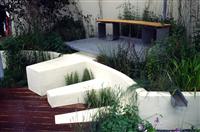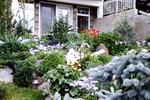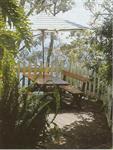
Develop Your Landscape Design Skills
Landscaping is an area of work which gets more complex the more you know. There are always lots of options for creating designs from choosing which materials to use, which plants to best suit the client's needs and the prevailing conditions, how to include garden features, and how to put it all together into a coherent design.
Expand your garden design abilities
A natural progression from Landscaping I, but a self contained study unit in its own right, that concentrates on the detail of creating individual components in a landscape. You learn to design and build such things as walls, rockeries, steps, ponds, & paving; and you develop skills to create specific effects in a garden.
COURSE STRUCTURE
There are twelve lessons in this subject as follows:
1. The Garden Environment
2. Landscape Materials
3. Using Bulbs and Annuals
4. Landscaping with Trees
5. Ground Cover Plants
6. Walls and Fences
7. Paths and Paving
8. Treatment of Slopes and Other Problem Areas
9. Garden Features
10. Designing for Low Maintenance
11. Development of a Landscape Plan
12. Management of Landscape Projects
AIMS
On completion of this course you should be able to:
Determine the resources required for a landscape development, including materials and equipment.
Determine appropriate plants for different locations within a landscape.
Determine the appropriate design and construction for landscape features, including walls, fences, pavers and buildings.
Determine treatments for problem areas in a landscape, including slopes and hostile environments.
Analyse maintenance requirements for a landscape.
Develop a landscape development plan, in accordance with a client brief, and in liaison with the client.
Plan the management of a landscape projects.
WHAT YOU WILL DO IN THIS COURSE
Determine landscape materials readily available in the learners locality, including: soils, gravels, mulches and timbers.
Differentiate between landscape applications for twenty different types of timber.
Compare a range of materials in terms of function and aesthetics, including five types of mulches and five types of gravels.
Determine applications for five different specific items of machinery in landscape construction including a chainsaw, an earth moving machine, a rotary hoe and a tractor.
List minimum equipment required to construct two different landscapes in accordance with project specifications.
Determine criteria for selecting plants to be planted in 3 specified locations.
Explain the impact of trees in two specific landscapes, on both the environment and aesthetics of those landscapes.
Determine twenty different herbaceous plants, to grow in three different specified locations within the same garden.
Prepare a design for an annual flower display bed of 50 sq. metres.
List five ground covers suited to plant in four different situations, including full shade , half shade, full sun and hanging baskets.
Prepare a planting design for a 100 sq. metre area of garden, using only ground covers and trees.
List ten trees suited to each of the following cultural situations, in your locality: waterlogged soil; sandy soil; heavy soil; saline soil; fire prone sites and near drainage pipes.
Explain local government regulations which are relevant to landscape design and construction.
Develop design criteria for different garden structures, in specified situations, including: a pergola, swimming pool, steps and a garden seat.
Compare the design and construction of six different types of barriers, including walls and fences.
Design a fence for a landscape designed by you, including: construction detail drawing(s), materials specifications and a cost estimate.
Compare ten specific surfacing materials, in landscapes visited by you, including paving products, stone and gravel.
Design a set of steps, including construction detail drawing(s), materials specifications and a cost estimate.
Design a set of retaining walls, including construction, drawings, materials needed and a cost estimate.
Compare different types of garden buildings observed by you, including sheds, gazebos, car ports and garages, in terms of cost, durability, aesthetics and maintenance required.
Determine two different methods to treat a specified erosion problem.
Determine landscape preparations required for different soil types including clay, sand, shale, rocky soil and loam.
Describe four interim stabilisation techniques, including hydromulching and jutemaster.
List fifteen plant species which will adapt well to problem situations.
Determine ten plants suitable for each of a range of different soil types, including: clays, sands, acidic soil and alkaline soil.
Develop landscape plans, including illustrations and written instructions, for three difficult sites.
Determine landscape features that contribute towards the reduction of maintenance requirement on a landscaped site.
Compare the weekly maintenance requirement of a specific low maintenance garden, with that of a specific high maintenance garden.
Compile pre-planning information for a an existing landscape, which owners require to be redeveloped in order to reduce the maintenance requirement.
Prepare a detailed landscape design to achieve low maintenance.
Develop a ten week maintenance program, for a specific landscaped area visited by you.
Compare copies of two landscape briefs for projects advertised in the tenders column of a newspaper.
Develop a "client" brief, through an interview with a potential landscape client.
Survey a landscape site to confirm details in a client brief.
Develop three alternative concept plans for a landscape, in accordance with a client brief.
Determine the preferred option, from three concept plans presented to a client at a tape recorded meeting.
Prepare a detailed landscape design, conforming to decisions made during a discussion of alternative concept plans.
Prepare a quotation, based on a specified landscape plan.
Analyse the design of a landscape in comparison with the "Brief".
Prepare a work schedule according to both specifications and plans.
Monitor the progress of landscape work on a project, by keeping a logbook or work diary.
Assess standard of work carried out on a completed landscape project, against landscape plans for that project.
Select appropriate equipment, including tools and machinery, for a specified project.
List occupational health and safety regulations when dealing with machinery and equipment, which is relevant to a specified project.
Schedule the supply of materials and equipment for a project, in the logbook.
Develop contingency plans for a landscape development which addresses different possible irregularities including bad weather, security problems, weekend watering.
Explain how to finalise a specified project prior to handing over.
Explain the importance of monitoring a contract, through a specified project.
Develop guidelines for supervision of construction for a specified landscape project.
MAKING THE HOUSE AND GARDEN ONE .... an article by our  Landscaping Tutors
Landscaping Tutors
How do you make a house look and feel appropriate within the garden that surrounds it? Some houses seem right for the garden whereas others just don’t.
What to do
*Houses need to be visually ‘tied’ into the garden.
By locating plants along the walls of a house to hide the base of those walls, the line which divides the building from the garden becomes blurred. As such, the building starts to seem more like it is just part of the garden.
This can be achieved by planting hedges, climbers or ground covers directly into the ground. Alternatively, install pots with plants on patios, decks, verandas and up steps that lead to the house.
*Consider the colour of the house.
Do you want to create contrast or harmony? If plant colours blend with the building, you can further blur the distinction between building and garden. If colours contrast you can create more stimulating views which can hold the onlookers attention and make the distinction between house and garden less noticeable.
*Texture
Similarly, by using plants that are of a similar texture to the building and adjoining areas you can once again mask the differences. The smooth silver textural bark of native gums will merge very well with smooth grey stone or concrete paving and walls. The flaky bark of silver birch will complement the flakiness of slate paving or roofing.
*Which style?
Certain garden styles are more suitable for certain properties. An ultra-modern architecturally designed house for instance, may clash with a garden that is full of traditional features such as classical sculpture. A cottage garden is more suited to a single-story residence than set among skyscrapers.
 Practical Concerns
Practical Concerns
*Shade
Planting too close to the house can shade a house making it feel cold in winter. It will, however make it feel cooler in summer.
*Tall Trees
These can cause a number of problems. Deciduous trees will drop leaves which can block drains and gutters resulting in extra maintenance. If they are planted too close to patios or houses, their roots can disrupt foundations and crack underground drains. They may also be prone to collapse in storm or cyclone conditions resulting in destruction to your property.
*Wood
It is not just piles of logs or garden prunings that can attract termites. They also find railway sleepers, wooden pergolas and decks highly desirable. You will need to check for termites regularly if you are using timber of any description to blend your house and garden.
*Dense Vegetation
If you allow vegetation to grow too dense it may attract potential garden pests, such as sheltering possums or rats. Wasps and bees may build their nests there and end up inside your home.
*Damp and Rot
Structures that are built close to the house will need sufficient drainage to avoid complications with wet rot and rising damp. Adequate ventilation will also be necessary to reduce the risk of fungal diseases on plants and timber. Where drains are exposed they need to be covered to prevent them from turning into rat runs.
*Choice of Plants
Some plants such as Hibiscus attract scale or aphids which in turn attract ants. If the branches are too close to windows then the ants may invade the house. Some plants can invade and even cause damage to buildings (eg. Climbers such as Creeping Fig, Ivy or Wisteria have been known to get into small gaps in a building, then expand causing structural damage).
How This Course Could Help You
This course is best suited to people with some existing knowledge of landscape design. However, people with basic construction skills and plant knowledge may also take it.
It could serve as a platform for further study or be taken in conjunction with other modules to enhance your learning experience. The course is of most value to people working in or wishing to work in:
Landscape construction
Garden design
Garden maintenance
Garden restoration or conservation
It could also add to the skillset of people wanting to start a garden design business, or be of value to people wishing to renovate a home garden.